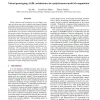281 search results - page 33 / 57 » Planning with Partial Preference Models |
MODELLIERUNG
2004
13 years 9 months ago
2004
: We consider socio-technical processes, i.e. processes where machines as well as humans participate. Typical examples occur in sales processes in e-commerce. Three modeling tasks ...
IBPRIA
2009
Springer
14 years 1 months ago
2009
Springer
In this paper we argue that maximum expected utility is a suitable framework for modeling a broad range of decision problems arising in pattern recognition and related fields. Exa...
JSW
2008
13 years 8 months ago
2008
Intermediate COCOMO Model computes effort as a function of program size and a set of cost drivers. Effort adjustment factor (EAF) is calculated using 15 cost drivers. EAF is an imp...
CSCLP
2008
Springer
13 years 10 months ago
2008
Springer
In this paper, we present a rule-based modelling language for constraint programming, called Rules2CP. Unlike other modelling languages, Rules2CP adopts a single knowledge represen...
MEMOCODE
2008
IEEE
14 years 2 months ago
2008
IEEE
While synchrony and asynchrony are two distinct concepts of concurrency theory, effective and formally defined embedded system design methodologies usually mix the best from both...

